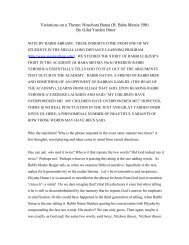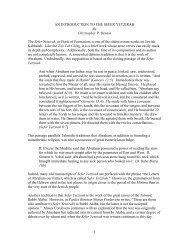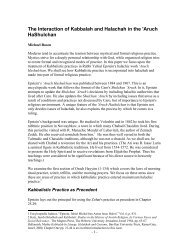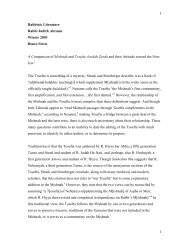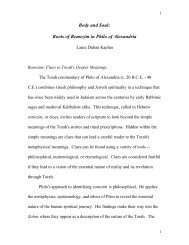The Symbolic Representation of the Sefer Torah - Maqom
The Symbolic Representation of the Sefer Torah - Maqom
The Symbolic Representation of the Sefer Torah - Maqom
You also want an ePaper? Increase the reach of your titles
YUMPU automatically turns print PDFs into web optimized ePapers that Google loves.
Otto’s understanding <strong>of</strong> <strong>the</strong> holy sheds an interesting light upon our understanding <strong>of</strong> <strong>the</strong> <strong>Sefer</strong><strong>Torah</strong>. Our initial point <strong>of</strong> departure is <strong>the</strong> belief that <strong>the</strong> content <strong>of</strong> <strong>the</strong> <strong>Sefer</strong> <strong>Torah</strong> is <strong>the</strong> word <strong>of</strong> Godgiven to Moses at Sinai. In <strong>the</strong>mselves, <strong>the</strong> scrolls are nothing more than inanimate objects, parchmentwith ink. <strong>The</strong> conviction in <strong>the</strong> doctrine <strong>of</strong> religion (<strong>the</strong> irrational) permits rabbis through <strong>the</strong> laws (<strong>the</strong>rational) to transform <strong>the</strong> object and awaken <strong>the</strong> believer to <strong>the</strong> level <strong>of</strong> <strong>the</strong> numinous, experiencing suchemotions as awe and excitement. Symbols, in contrast to <strong>the</strong> beliefs <strong>of</strong> Tillich (1957, p. 43), can beproduced intentionally to be developed from within <strong>the</strong> individual or <strong>the</strong> collective unconscious. <strong>The</strong> nonrationalconveyed through <strong>the</strong> numinous becomes structured through <strong>the</strong> eyes <strong>of</strong> <strong>the</strong> rational rabbinic legalsystem; strict laws alone would not be sufficient to induce and arouse spiritual excitement and feeling,which must be based on personal belief, in our case that <strong>the</strong> <strong>Torah</strong> represents <strong>the</strong> word <strong>of</strong> G-d. Specific anddetailed requirements contribute to and enhance <strong>the</strong> feeling <strong>of</strong> creation <strong>of</strong> <strong>the</strong> numinous. From <strong>the</strong> outset,<strong>the</strong> parchment on which <strong>the</strong> <strong>Torah</strong> scroll was written had to be taken from a kosher animal and preparedaccording to very precise instructions. Any deviation from <strong>the</strong> rules eliminated and prohibited <strong>the</strong> use <strong>of</strong><strong>the</strong> parchment as well as <strong>the</strong> ink. Fear results from <strong>the</strong> possibility <strong>of</strong> mishandling <strong>the</strong> <strong>Torah</strong> scrolls, and <strong>of</strong><strong>the</strong> punishments that accompany this. <strong>The</strong> grand ritual ceremony <strong>of</strong> removing <strong>the</strong> <strong>Torah</strong> scrolls from <strong>the</strong>Holy Ark, and <strong>the</strong> actual display <strong>of</strong> its content, kindles <strong>the</strong> congregant’s religious awe and emotionalattachment to its power and holiness. <strong>The</strong> moment <strong>of</strong> <strong>the</strong> removal <strong>of</strong> <strong>the</strong> <strong>Torah</strong> from <strong>the</strong> Holy Ark is <strong>the</strong>point where <strong>the</strong> inanimate object (<strong>the</strong> <strong>Torah</strong>) acquires <strong>the</strong> numen through its contact with <strong>the</strong> congregation.<strong>The</strong> opportunity for engaging in physical contact and kissing <strong>the</strong> “holy” intensifies <strong>the</strong> power attributed to<strong>the</strong> <strong>Sefer</strong> <strong>Torah</strong>.Additional elements such as art fur<strong>the</strong>r enhance <strong>the</strong> emotions evoked towards <strong>the</strong> <strong>Torah</strong>. Otto (1958,pp. 65-70) argues “<strong>the</strong> most effective means <strong>of</strong> representing <strong>the</strong> numinous is <strong>the</strong> sublime.” Religioussculptures and paintings have throughout history accomplished this. Judaism, based on <strong>the</strong> explicit ruling<strong>of</strong> <strong>the</strong> Decalogue, “You shall not make for yourself a graven image, or any likeness <strong>of</strong> anything that is inheaven above, or that is in <strong>the</strong> earth beneath or that is in <strong>the</strong> water under <strong>the</strong> earth” (Exodus 20:4), couldnot allow for most <strong>of</strong> <strong>the</strong> artwork that can evoke <strong>the</strong> spiritual feelings created by great artistic37



